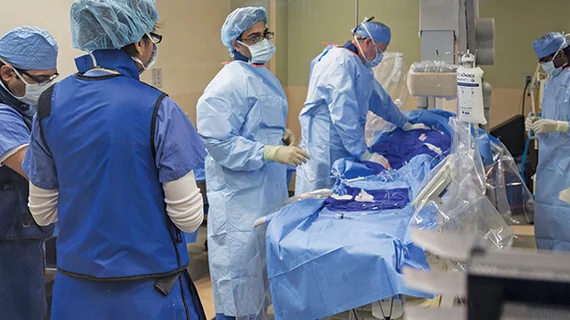Specialized surgical staff for CABG improves mortality rates, reduces complications
Patients who undergo coronary artery bypass grafting (CABG) have shorter operations, fewer complications and better survival rates if they have surgeons who are subspecialized in CABG, researchers report in The Annals of Thoracic Surgery.
“Studies suggest hospital and surgeon volume may both increase the repair rate and operative survival in mitral valve surgery,” wrote Claire Watkins, MD, of the department of cardiothoracic surgery at the Stanford University School of Medicine in California, and colleagues. “Higher-volume cardiac surgery centers have been shown to have improved outcomes after repair of acute aortic dissections. However, results for or against subspecialization in CABG are equivocal.”
Watkins and colleagues sought to determine whether the development of a subspecialized coronary surgery would positively impact morbidity and mortality outcomes using data from patients who underwent CABG at the University of Maryland Medical Center (UMMC) in Baltimore, Maryland.
UMMC launched a specialized CABG surgery program in 2013, so the data were separated into two groups—the “general era," which was 2002 to 2012, and the "specialized era," which was 2013 to 2016.
During the general era, 3,256 patients underwent CABG, and 1,283 patients had CABG surgery during the specialized era.
A senior surgeon who specialized in coronary surgery was recruited and appointed as the clinical director of the program and he also completed 70 percent of the CABG operations during the specialized era. The researchers found:
- Mortality rates decreased from almost 3 percent to 1.48 percent three years after a more specialized coronary surgery program was implemented at UMMC.
- The researchers estimated that five deaths may have been prevented in the three years after implementation.
- Overall operation time decreased by 48 minutes from incision to closure, due to standardized surgical approaches and operative techniques in the updated program.
- Bilateral internal mammary artery use increased.
- Blood transfusions decreased from 49 percent to 36 percent.
- There was a decrease in stroke complications—from almost 2 percent to less than 1 percent.
The authors noted several explanations for their findings including strengthened mentoring and quality review, which allowed surgeons the best possible outcomes for their efforts. Additionally, the authors said, shifts in care and accountability among the surgical team may have resulted in better outcomes.
“Our experience suggests that it is not simply case volume that can improve isolated CABG outcomes but rather a more focused surgeon, team, and program,” Watkins et al. said. “Without the program development seen in other areas, such as transplant, congenital, or valve surgery, CABG surgeons may be vulnerable to variable outcomes. Through designated leadership of a coronary surgery program, standardization of all aspects of coronary care, and rigorous quality review, the lofty goal of less than 1 percent operative mortality can be consistently achieved.”

